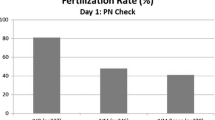Purpose
The aim of this work was to determine the morphology of the zona pellucida surface of immature and in vitro matured mouse oocytes by scanning electron microscopy. For this purpose two groups of immature oocytes (germinal vesicle group and metaphase I group) were studied either before or after in vitro maturation.
Results
Before in vitro maturation, the germinal vesicle immature group showed mainly an unstructured zona pellucida surface with smooth cumulus cells. The metaphase I immature group showed a more structured zona pellucida with smooth or blebbing cumulus cells. After in vitro maturation, development of the zona pellucida toward a mature surface, related to the initial degree of oocyte maturity, was observed in both groups.
Conclusions
These observations show a correlation between the morphology of the zona pellucida surface and the degree of oocyte maturity; the in vitro maturation process can give rise to a proper development of this endowment when immature oocytes are used.
Similar content being viewed by others
References
Pincus G, Enzmann EV: The comparative behaviour of mammalian eggs in vivo and in vitro. I. The activation of ovarian eggs. J Exp Med 1935;62:665–675
Edwards RG: Maturation in vitro of mouse, sheep, cow, pig, rhesus monkey and human ovarian oocytes. Nature 1965;208:349–351
Moore RM, Trounson AO: Hormonal and follicular factors affecting maturation of sheep oocytes in vitro and their subsequent developmental capacity. J Reprod Fertil 1977;49:101–109
Thibault C: Are follicular maturation and oocyte maturation independent processes? J Reprod Fertil 1977;51:1–15
Van Blerkom J, McGaughey RW: Molecular differentiation of the rabbit ovum. II. During the preimplantation development of in vivo and in vitro matured oocytes. Dev Biol 1978;63:151–164
Leibfried-Rutledge ML, Crister ES, Eyestone WH, Northey DL, First NL: Development potential of bovine oocytes matured in vitro or in vivo. Biol Reprod 1987;36:376–383
Schroeder AC, Eppig JJ: The developmental capacity of mouse oocytes that matured spontaneously in vitro is normal. Dev Biol 1984;102:493–497
Zhang X, Armstrong DT: Effects of follicle-stimulating hormone and ovarian steroids duringin vitro meiotic maturation on fertilization of rat oocytes. Gam Res 1989;23:267–277
Cha KY, Koo JJ, Ko JJ, Choi DH, Han SY, Yoon TK: Pregnancy after in vitro fertilization of human follicular oocytes collected from nonstimulated cycles, their culture in vitro and their transfer in a donor oocyte program. Fertil Steril 1991;55:109–113
von Weymarn N, Guggenheim R, Müller HJ: Surface characteristics of oocytes from juvenile mice as observed in the scanning electron microscope. Anat Embryol 1980;161:19–27
Tesarík J, Pilka L, Trávník P: Zona pellucida resistance to sperm penetration before the completion of human oocyte maturation. J Reprod Fertil 1988;83:487–495
Nogués C, Ponsà M, Vidal F, Boada M, Egozcue J: Effects of aging on the zona pellucida surface of mouse oocytes. J Vitro Fert Embryo Transfer 1988;5:225–229
Familiari G, Nottola SA, Micara G, Aragona C, Motta P: Is the sperm-binding capability of the zona pellucida linked to its surface structure? A scanning electron microscopic study of human in vitro fertilization. J Vitro Fert Embryo Transfer 1988;3:134–143
Familiari G, Nottola SA, Micara G, Aragona C, Motta P: Human in vitro fertilization: The fine three-dimensional architecture of the zona pellucida.In Developments in Ultrastructure of Reproduction. New York, Alan R Liss, 1989, pp 334–344
Motta PM, Nottola SA, Micara G, Familiari G: Ultrastructure of human unfertilized oocytes and polyspermic embryos in an IVF-ET program.In In Vitro Fertilization and Other Assisted Reproduction, Jones HW, Schrader C (eds). New York, Annals of the New York Academy of Sciences, 1988, pp 367–383
Jacowsky S, Dumont JN: Surface alterations of the mouse zona pellucida and ovum following in vivo fertilization: Correlation with the cell cycle. Biol Reprod 1979;20:150–161
Phillips DM, Shalgi R: Surface architecture of the mouse and hamster zona pellucida and oocyte. J Ultrastruct Res 1980;72:1–12
Quinn P, Barros C, Whittingham DG: Preservation of hamster oocytes to assay the fertilizing capacity of human spermatozoa. J Reprod Fertil 1982;66:161–168
Whittingham DG: Culture of mouse ova. J Reprod Fertil 1971;14:7–21
Sundstrom P: Interaction between spermatozoa and ovum in vitro.In Atlas of Human Reproduction by Scanning Electron Microscopy, Hafez ESE, Kenemans P (eds). Lancaster, MTP Press, 1982, pp 225–230
Dekel N, Phillips DM: Maturation of the rat cumulus oophorus. A scanning electron microscopy study. Biol Reprod 1979;21:9–18
Author information
Authors and Affiliations
Rights and permissions
About this article
Cite this article
Calafell, J.M., Nogués, C., Ponsà, M. et al. Zona pellucida surface of immature and in vitro matured mouse oocytes: Analysis by scanning electron microscopy. J Assist Reprod Genet 9, 365–372 (1992). https://doi.org/10.1007/BF01203961
Received:
Accepted:
Issue Date:
DOI: https://doi.org/10.1007/BF01203961




